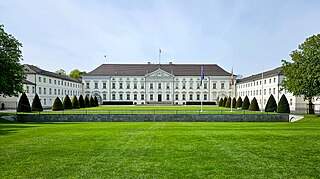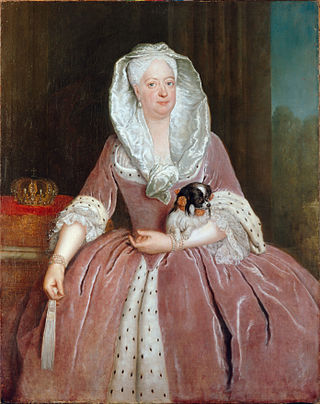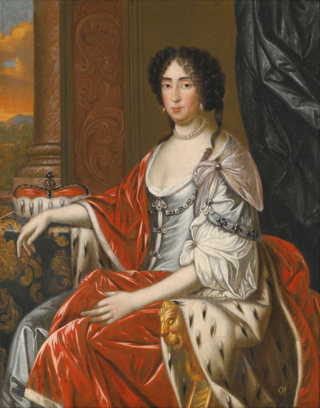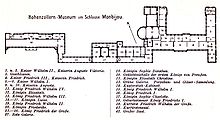
Andreas Schlüter was a German baroque sculptor and architect, active in the Holy Roman Empire of the German Nation, the Polish–Lithuanian Commonwealth, and the Russian Tsardom.

Frederick William was Elector of Brandenburg and Duke of Prussia, thus ruler of Brandenburg-Prussia, from 1640 until his death in 1688. A member of the House of Hohenzollern, he is popularly known as "the Great Elector" because of his military and political achievements. Frederick William was a staunch pillar of the Calvinist faith, associated with the rising commercial class. He saw the importance of trade and promoted it vigorously. His shrewd domestic reforms gave Prussia a strong position in the post-Westphalian political order of Northern-Central Europe, setting Prussia up for elevation from duchy to kingdom, achieved under his son and successor.

Frederick William I, known as the Soldier King, was King in Prussia and Elector of Brandenburg from 1713 till his death in 1740, as well as Prince of Neuchâtel.

The House of Hohenzollern is a formerly royal German dynasty whose members were variously princes, electors, kings and emperors of Hohenzollern, Brandenburg, Prussia, the German Empire, and Romania. The family came from the area around the town of Hechingen in Swabia during the late 11th century and took their name from Hohenzollern Castle. The first ancestors of the Hohenzollerns were mentioned in 1061.

Frederick I, of the Hohenzollern dynasty, was Elector of Brandenburg (1688–1713) and Duke of Prussia in personal union (Brandenburg-Prussia). The latter function he upgraded to royalty, becoming the first King in Prussia (1701–1713). From 1707 he was in personal union the sovereign prince of the Principality of Neuchâtel.

Brandenburg-Prussia is the historiographic denomination for the early modern realm of the Brandenburgian Royal dynasty of the House of Hohenzollern between 1618 and 1701. Based in the Electorate of Brandenburg, the main branch of the Hohenzollern intermarried with the branch ruling the Duchy of Prussia, and secured succession upon the latter's extinction in the male line in 1618.

Unter den Linden is a boulevard in the central Mitte district of Berlin, Germany. Running from the Berlin Palace to the Brandenburg Gate, it is named after the linden trees that line the grassed pedestrian mall on the median and the two broad carriageways. The avenue links numerous Berlin sights, landmarks and rivers for sightseeing.

Charlottenburg is a locality of Berlin within the borough of Charlottenburg-Wilmersdorf. Established as a town in 1705 and named after Sophia Charlotte of Hanover, Queen consort of Prussia, it is best known for Charlottenburg Palace, the largest surviving royal palace in Berlin, and the adjacent museums.

The Berlin Palace, formally the Royal Palace and also known as the City Palace, is a large building adjacent to Berlin Cathedral and the Museum Island in the Mitte area of Berlin. It was the main residence of the House of Hohenzollern from 1443 to 1918. Expanded by order of Frederick I of Prussia according to plans by Andreas Schlüter from 1689 to 1713, it was thereafter considered a major work of Prussian Baroque architecture. The royal palace became one of Berlin’s largest buildings and shaped the cityscape with its 60-meter-high (200 ft) dome erected in 1845.

Bellevue Palace, located in Berlin's Tiergarten district, has been the official residence of the president of Germany since 1994. The schloss is situated on the banks of the Spree river, near the Berlin Victory Column, along the northern edge of the Großer Tiergarten park. Its name – the French for "beautiful view" – derives from its scenic prospect over the Spree's course.

Sophia Dorothea of Hanover was Queen in Prussia and Electress of Brandenburg during the reign of her husband, King Frederick William I, from 1713 to 1740. She was the mother of Frederick the Great.

Sophia Charlotte of Hanover was the first Queen consort in Prussia as wife of King Frederick I. She was the only daughter of Elector Ernest Augustus of Hanover and his wife Sophia of the Palatinate. Her eldest brother, George Louis, succeeded to the British throne in 1714 as King George I.

The Antique Temple is a small round temple in the west part of Sanssouci Park in Potsdam. Frederick the Great had the building constructed to house his collection of classical works of art, antique artifacts, coins and antique gems. Carl von Gontard created the building in 1768/69 near the New Palace north of the Central Alley, as a complement to the Temple of Friendship situated south of the Alley. Since 1921 the Antique Temple has been used as a mausoleum for members of the House of Hohenzollern and is not open to the public.

Prince Augustus Ferdinand of Prussia was a Prussian prince and general, as well as Herrenmeister of the Bailiwick of Brandenburg of the Order of Saint John. He belonged to the House of Hohenzollern, and was the youngest son of Frederick William I of Prussia by his wife, Queen Sophia Dorothea.

Landgravine Elisabeth Henriëtte von Hessen-Kassel was the daughter of William VI, Landgrave of Hesse-Kassel and Hedwig Sophia of Brandenburg (1623–1683) and electoral princess of Brandenburg through her marriage to Frederick I of Prussia.

Frederick William of Brandenburg-Schwedt was a German nobleman. In his lifetime, from 1711 to 1771, he held the titles Prince in Prussia and Margrave of Brandenburg, with the style Royal Highness. He was made a knight of the Order of the Black Eagle.

Princess Dorothea of Schleswig-Holstein-Sonderburg-Glücksburg, was Duchess consort of Brunswick-Lüneburg by marriage to Christian Louis, Duke of Brunswick-Lüneburg, and Electress of Brandenburg by marriage to Frederick William, Elector of Brandenburg, the "Great Elector".

Philip William, Prince in Prussia was a Prussian Prince, was the first owner of the Prussian secundogeniture of Brandenburg-Schwedt and was governor of Magdeburg from 1692 to 1711.

Oranienburg Palace is a Schloss located in the town of Oranienburg in Germany.

Henriette Maria of Brandenburg-Schwedt, was a granddaughter of the "Great Elector" Frederick William of Brandenburg. She was the daughter of Philip William, Margrave of Brandenburg-Schwedt (1669-1711), the eldest son of the elector's second marriage with Sophia Dorothea of Schleswig-Holstein-Sonderburg-Glücksburg. Her mother was Johanna Charlotte (1682-1750), the daughter of Prince John George II, Prince of Anhalt-Dessau.


























